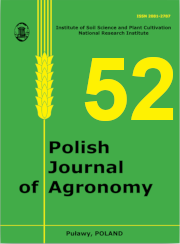Effect of cultivar and nitrogen fertilisation on grain and protein yield in sorghumtein yield in sorghum
##plugins.themes.bootstrap3.article.main##
Abstrakt
Sorghum is a cereal crop of major importance in global production. It is grown in hot and dry regions of the world. In Poland, this species has so far not been cultivated for grain due to unfavourable climatic conditions. Currently, climate warming and the extension of the growing season provide an opportunity to introduce sorghum into grain cultivation. Three grain sorghum cultivars Albanus, Anggy, GK Emese were used in the ongoing microplot trials and three different nitrogen rates were applied: 80, 100 and 120 kg ha-1. The research was conducted over two growing seasons. The aim of the study was to determine the effect of cultivar and level of nitrogen fertilisation on the yield, yield structure and grain protein content of sorghum. A differentiated response of cultivars to nitrogen fertilisation was shown. Albanus and Anggy cultivars have similar yield potential and reaction to nitrogen fertilisation, and the optimum nitrogen dose for the cultivars is 100 kg of nitrogen per hectare, and an increased dose does not significantly increase the yield. Regardless of the level of nitrogen fertilization, the GK Emese variety always showeda higher protein yield compared to the other tested sorghum varieties. The cultivar GK Emese showed the highest yield potential. In 2020 it exhibited the highest increase in grain and protein yield along to increase of nitrogen fertilisation.
##plugins.themes.bootstrap3.article.details##

Utwór dostępny jest na licencji Creative Commons Uznanie autorstwa – Na tych samych warunkach 4.0 Miedzynarodowe.
Autor udziela redakcji czasopisma Polish Journal of Agronomy (w skrócie: PJA) licencji niewyłącznej i nieodpłatnej na korzystanie z autorskich praw majątkowych do wersji papierowej/drukowanej i elektronicznej utworu Autora opublikowanego w PJA w kraju i za granicą, w całości lub w dowolnej części, w tym umieszczanie utworu w elektronicznych bazach/zbiorach danych lokalnych lub dostępnych w Internecie, przez czas nieograniczony na polach eksploatacji określonych w art. 50 ustawy o prawie autorskim i prawach pokrewnych.
Prace wydane w Polish Journal of Agronomy są udostępniane na licencji Creative Commons Uznanie autorstwa-Na tych samych warunkach 4.0 (CC-BY-SA).

